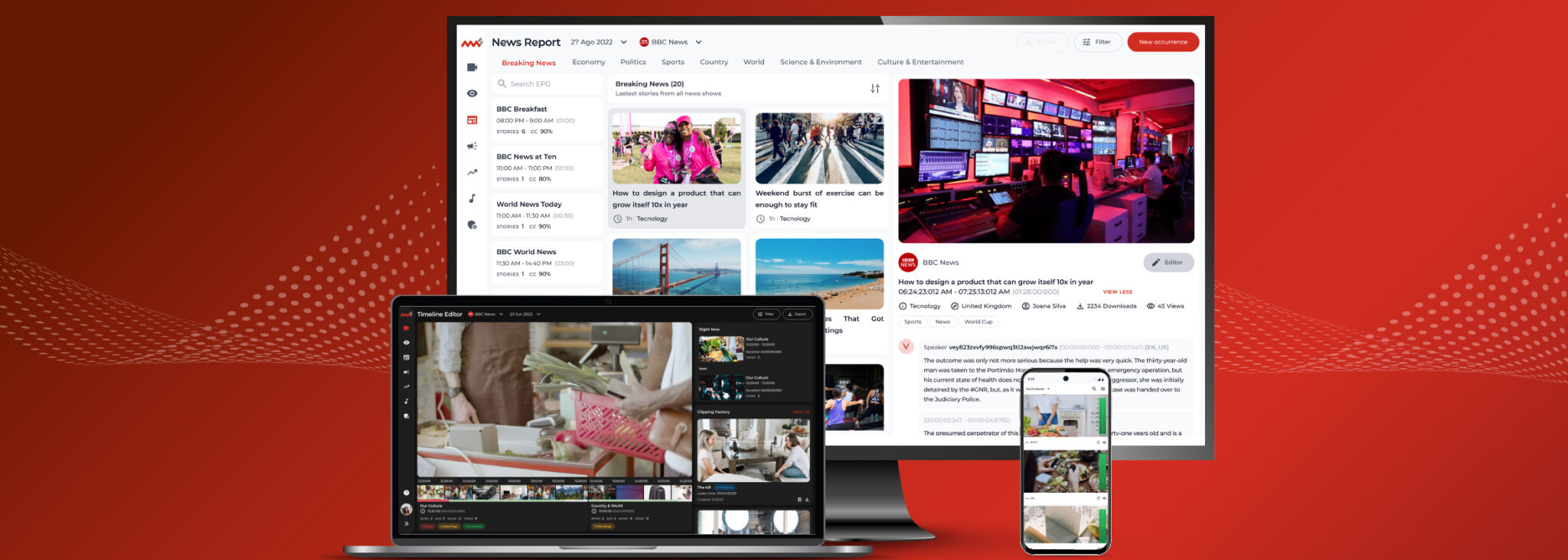In an increasingly demanding media consumption landscape, broadcasters can utilize automatic speech recognition (ASR) to overcome burdensome tasks, extract valuable information and gain a deeper understanding of their programming. This AI-driven technology uses advanced machine learning algorithms and deep neural networks. This enables higher accuracy in transcribing spoken content and vocabulary customization while enhancing real-time monitoring features and data analytics procedures.
By continuously transcribing aired content and linking frame-accurate media events to AI-generated textual metadata, broadcasters can optimize resources required for content creation, review, indexing, and sharing, while being swift to respond to regulatory compliance inquiries. This content classification network facilitates an effective “new content discovery,” as it empowers newsroom teams to find trending news and streamline their clipping workflows. Other departments may use similar features to generate data-driven reports for compliance, ads, royalties, and rating performance.
Leveraging this technology is transformative in terms of automation, reducing costs, and mitigating risks of non-compliance — effectively future-proofing your organization.
Spotting trends, simplifying compliance
In addition to a full-text transcription and the extraction of closed captioning, the AI algorithms can detect recurring topics, keywords, and themes across the newscast or other programs. By merging this textual information with ratings, it’s possible to automatically categorize, tag and segment the content according to performance or subject. This trend analysis provides valuable insights into audience preferences, content performance, and emerging patterns, informing programming decisions and compliance monitoring.

João Neto, CEO VoiceInteraction
Content indexation enables an efficient search and retrieval of specific segments within recorded content. This streamlines the clipping process and reduces manual effort. Broadcasters optimize workflows, eliminate errors, and improve efficiency by integrating these automated processes. Accurate content classification further ensures compliance with regulations, as the comprehensive and searchable textual record generated by speech-to-text technology aids audits and report generation.
Prompt responses to regulatory inquiries are facilitated by accurate textual representations, enabling broadcasters to retrieve relevant segments, validate compliance, and provide comprehensive responses. Gathering this compliance-related data helps broadcasters refine content policies, update guidelines, and develop targeted training programs, enhancing overall compliance practices.
Driving audience engagement with personalized content
With the right technology partner, broadcasters can revolutionize the industry by creating personalized content experiences tailored to individual options. As the preference for on-demand content grows uncontested, it becomes necessary to implement content classification and user-specific delivery strategies for linear broadcasting.
AI-driven speech-to-text technology realizes this vision by allowing for efficient indexing and asset management. Transcribed content can be automatically tagged, categorized, and organized, enabling content discovery workflows and user-tailored content delivery.
The emergence of ATSC 3.0, also known as NextGen TV, brings exciting advancements to the broadcasting industry. This broadcasting standard enables user-specific content delivery, empowering broadcasters to provide personalized experiences. ATSC 3.0 supports advanced targeted advertising capabilities, leveraging user data based on demographics, preferences, and viewing habits to deliver the right ads. Broadcasters thus enhance the relevance and effectiveness of advertising, resulting in a more engaging and personalized experience for viewers. Going beyond commercials, broadcasters could deliver tailored news recaps to specific users, based on their preferences. Even without this broadband connectivity, Television stations and Networks can invest in their brand recognition through online dedicated news platforms, websites, or streaming channels.
By repurposing their content online, broadcasters can drive engagement and create new monetization opportunities. Viewers now have a selection of clips based on their preferences and subjects of interest. They can quickly locate specific segments or topics for re-watching. These are solid strategies to enhance satisfaction, increase engagement, and cultivate a loyal user base.
Embracing artificial intelligence in broadcast compliance
These advancements allow broadcasters to adapt to evolving regulations swiftly and maintain their reputation as responsible entities. It also maximizes ad revenue and lowers operational costs by creating libraries of indexed video content and providing valuable insights for programming decisions. These integrations facilitate collaboration among compliance agents, newsroom teams, ad sales, program directors, and content creators.

Harnessing the power of AI enables the delivery of exceptional content experiences. Broadcasters can navigate the current dynamic media landscape confidently and drive growth by embracing these advancements.



































Comments (1)
LunwenHelp says:
September 26, 2023 at 5:25 am
Homework assistance for international students is a key tool for enhancing academic abilities. By fully utilizing this resource, international students can overcome language barriers, understand academic standards, receive feedback and guidance, manage time and stress, and boost their confidence. However, the key lies in actively seeking homework help http://www.12y.org/ , participating in academic discussions, and continuously improving their academic skills. Homework assistance for international students is not merely a provider of answers but also a partner in guiding international students toward academic success.